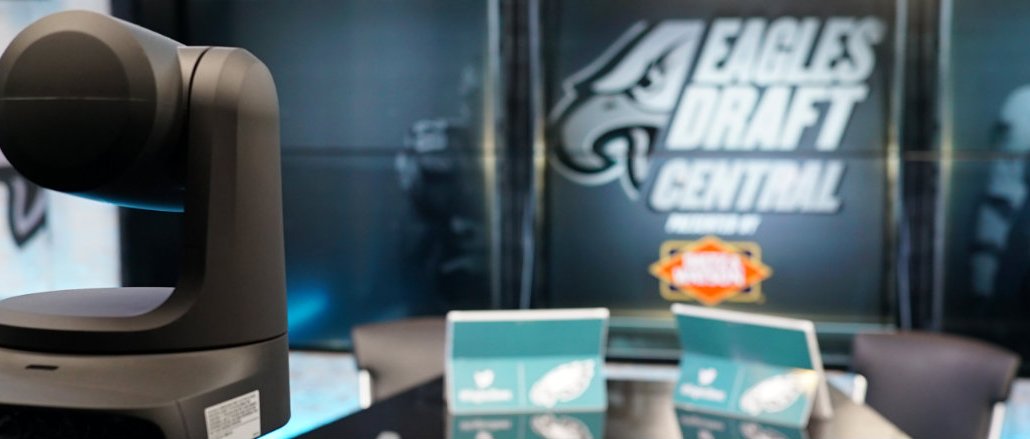Connect with execs from The New York Times, TIME, Dotdash Meredith and many more

The Philadelphia Eagles have a message for any publisher looking to experiment with live video: Before going live, ask yourself if the content absolutley needs to be delivered in that way.
The Eagles are no strangers to live streaming video. Between the team’s website, mobile app and social channels on Facebook and Twitter, the Eagles are streaming anywhere between 10 to 15 hours of live video every week during the NFL season. This includes two hourlong studio shows hosted by Eagles content manager Chris McPherson before and after every game, as well as a daily half-hour show hosted by Eagles reporter Dave Spadaro. The Eagles also produce a halftime report and make full press conferences available on their own platforms and social channels.
The live productions mimic what sports fans are used to seeing on TV: Good video quality, studio sets, analysis and commentary using game footage, on-screen graphics and multiple camera angles. This content is produced by the Eagles’ video division, which is made up of 15 full-time staffers as well as 15 additional seasonal assistants.
The overall number of live hours of video produced by the Eagles has actually dropped over the past couple of years, according to Mark Leblang, the studio/live production manager for the Eagles. “It’s not because we haven’t been able to,” he said. “The philosophy on what needs to be live has changed.”
For instance, the Eagles used to have a two-hour daily call-in show called “Eagles Live,” which was streamed live on its own digital platforms. According to Leblang, the show had a healthy audience, but there wasn’t any growth, which made it tougher to justify the resources and manpower needed to produce high-quality live content. The Eagles still produce daily show called “Eagles 360,” the only difference is that it’s not live.
“People are still coming to us to watch this programming, but they’re doing it in a way that caters to their own unique schedules,” Leblang said. “We live in an on-demand world and the audience is going to tell you when the best time is for them to engage with your content — and the answer, most of the time, is whenever they feel like it.”
In other words: Unless the content is “unique or newsworthy, it does not need to be live,” Leblang said.
For the Eagles, this means a lot of live video on game day. The team averages 60,000 to 75,000 unique viewers for its live content every game day during the season, Leblang said. Roughly 85 to 90 percent of viewers are outside of the local Philadelphia TV market, which means the team is serving the part of its fanbase that’s underserved by mainstream media options.
The Eagles are also going live when the team can offer something that other media outlets can’t. For instance, this coming Monday, the team is hosting a ceremony for two new inductees into the Eagles’ hall of fame. The team will provide live coverage of the event, which has no other media outlets attending.
The Eagles are live streaming on Facebook but not directly through the Facebook Live tool. Instead, the team has partnered with live streaming tech company Livestream to deliver these broadcasts, which can be distributed on its own site and app as well as on Facebook and Periscope.
This is because the social platforms have “warts” in terms of what they can and can’t do, Leblang said. For instance, on Facebook Live and Twitter, the Eagles can’t go back and trim unnecessary footage from the beginning and end of the broadcasts — on Livestream, the team can.
“We don’t want [on-demand] viewers to have to sit through a ‘stay tuned’ screen,” said Leblang. “It doesn’t make for a great experience.”
Image via the Philadelphia Eagles
More in Media

Three publishers’ workforce diversity reports show DEI efforts remain sluggish
Overall, staff diversity at The New York Times, Hearst and Condé Nast has either marginally improved or stalled in 2024, according to their annual workforce diversity data this year.

Retail media meets publishing: News UK, Future and Ocado tap clean room tech for smarter data targeting
News UK, The Independent, Immediate Media and Future are teaming up with retail media network Ocado to test clean room-powered data matching.

From sidelines to spotlight: Esports events are putting creators center stage
Esports events’ embrace of content creators reflects advertisers’ changing priorities across both gaming and the wider culture. In the past, marketers viewed esports as one of the best ways to reach gamers. In 2025, brands are instead prioritizing creators in their outreach to audiences across demographics and interest areas, including gaming.





